Efford is an historic manor formerly in the parish of Eggbuckland, Devon, England. Today it has been absorbed by the city of Plymouth to become a large, mostly post-World War II, eastern suburb of the city. It stands on high ground approximately 300 feet above the Laira estuary of the River Plym and provides views over long distances: to the north across Dartmoor, to the east and south-east across the South Hams. It consists predominantly of local authority and housing association properties. Before this land was built upon it was known as 'The Wilds of Efford', and was largely unspoilt countryside and marsh land. That a deer park may have been attached to the manor is suggested by the survival of the street name "Deer Park Drive".

Roborough is a village and civil parish 5.5 mi (8.9 km) from Great Torrington, in Devon, England. Situated topographically on the plateau between the Torridge and Taw Rivers, the parish covers 1,258 ha and contains a population of some 258 parishioners. It is surrounded by a pastoral landscape of rectangular fields, high hedges and scattered farmsteads.

Potheridge is a former Domesday Book estate in the parish of Merton, in the historic hundred of Shebbear, 3 miles south-east of Great Torrington, Devon, England. It is the site of a former grand mansion house re-built by George Monck, 1st Duke of Albemarle (1608–1670) circa 1660 on the site of the former manor house occupied by his family since at the latest 1287. It was mostly demolished in 1734 after the death of the widow of his son Christopher Monck, 2nd Duke of Albemarle.
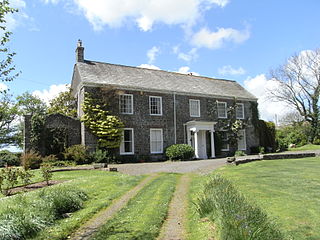
Thuborough in the parish of Sutcombe, Devon, England, is an historic estate, formerly a seat of a branch of the Prideaux family, also seated at Orcharton, Modbury; Adeston, Holbeton; Soldon, Holsworthy; Netherton, Farway; Ashburton; Nutwell, Woodbury; Ford Abbey, Thorncombe, all in Devon and at Prideaux Place, Padstow and Prideaux Castle, Luxulyan, in Cornwall. The present mansion house, comprising "Thuborough House" and "Thuborough Barton", the north-east block, is a grade II listed building.
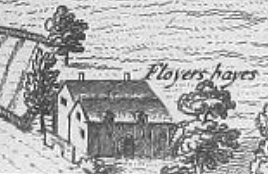
Floyer Hayes was an historic manor in the parish of St Thomas on the southern side of the City of Exeter in Devon, England, from which city it is separated by the River Exe. It took its name from the ancient family of Floyer which held it until the early 17th century, when it was sold to the Gould family. In the 19th century the estate was divided up and the manor house demolished. The parish church of St Thomas, situated a short distance to the west of the house, was burned down in 1645 during the Civil War, and was rebuilt before 1657. Thus no monuments survive there of early lords of the manor, namely the Floyer family.

Widworthy is a village, parish and former manor in East Devon, Devon, England. The village is 3 1/2 miles east of Honiton and the parish is surrounded clockwise from the north by the parishes of Stockland, Dalwood, Shute, Colyton, Northleigh, and Offwell. The parish church is dedicated to St Cuthbert. Near the church is Widworthy Barton, the former manor house, which is largely unaltered from its early 17th century form. Widworthy Court is a mansion within the parish built in 1830 by Sir Edward Marwood-Elton to the design of G.S. Repton. In 2011 the parish had a population of 296.
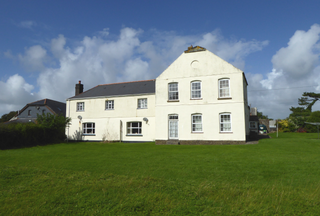
Webbery is an historic manor in the parish of Alverdiscott in North Devon, England.
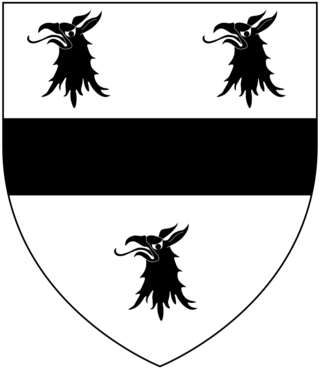
Kenedon is an historic manor situated in the parish of Sherford in Devon.

South Milton is a village and civil parish in the South Hams district, in the county of Devon, England, situated on the south coast about 2 miles south-west of Kingsbridge. The civil parish includes the hamlets of Sutton, south of the village, and Upton, north of the village. In 2021 the parish had a population of 371.
Collacombe is an historic manor in the parish of Lamerton, Devon, England. The manor house survives as a grade I listed building, known as Collacombe Barton or Collacombe Manor (House).

Whiteway is an historic estate in the parish of Kingsteignton, Devon. It should be distinguished from Whiteway House in the parish of Chudleigh, Devon, 4 3/4 miles (7.6 km) to the north, in the 18th century a seat of the Parker family of Saltram.
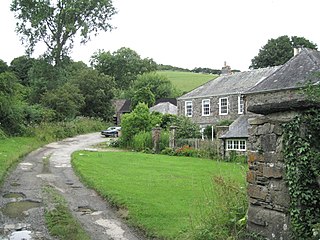
Luscombe is an historic estate situated in the parish of Rattery in Devon.
The manor of Broad Hempston was a historic manor situated in Devon, England, about 4 miles north of Totnes. The present village known as Broadhempston was the chief settlement within the manor and remains the location of the ancient parish church of St Peter and St Paul.

Spurway is a historic manor in the parish of Oakford in Devon. It was the seat of the de Spurway family from before 1244 until the mid-20th century. The derelict buildings of Spurway Barton are in a remote location above a wooded combe.

Robert Bastard (fl.1086) was a Norman warrior who assisted in the 1066 Norman Conquest of England under King William the Conqueror. He was subsequently rewarded with landholdings in Devonshire and is one of the Devon Domesday Book tenants-in-chief of that monarch, with a holding of 10 manors or estates held in chief, 8 of which he held in demesne, i.e. under his own management without tenants. He had at least one further holding as a mesne tenant, at Goosewell, Plymstock parish, Plympton hundred, held from William of Poilley, a Norman tenant-in-chief from Poilley in Normandy, most of whose 21 landholdings were later granted by King Henry I (1100–1135) to his trusted supporter Richard de Redvers, feudal baron of Plympton in Devon.

Hareston is an historic estate in the parish of Brixton, about three miles from Plymouth in Devon. The mansion house built during the reign of King Henry VII (1485-1509) burned down partially in an accidental fire at the beginning of the 18th century, and in 1822 the surviving part, the Hall and Chapel, was being used as a farmhouse. It was described by Candida Lycett Green in her 1991 book The Perfect English Country House as: "The most forgotten Manor House Farm In England, untouched for hundreds of years, sits safely, impossible to find, down miles of private sunken lanes which in the spring brim with Campion, Bluebells, Purple Orchids, Primroses, Violets, Speedwell and Stitchwort. Wooded hills rise behind this, the quintessence of an ancient English Manor House".

Speccot is an historic estate in the parish of Merton in Devon, England. It was the seat of the de Speccot family, one of the oldest gentry families in Devon, which founded almshouses at Taddiport, near Great Torrington, Devon, in the 13th century. It is situated about one mile south-west of Potheridge, the seat of the Monck family from before 1287 to the late 17th century, who were thus close neighbours of the de Speccot family for many centuries. The present farmhouse known as "Speccot Barton" is Victorian and although no obvious traces of an earlier house survive, is marked "On Site of a Mansion" on the First Edition Ordnance Survey 25 inch map of 1880-99. The estate is today operated as a family-run sheep farm with six holiday cottages to let. A smaller house known as "Little Speccot" is situated on the approach lane to Speccot Barton.
Croker's Hele is an historic estate in the parish of Meeth in Devon, England.

Spridleston is an historic manor in the parish of Brixton in Devon, England, long a seat of a branch of the prominent and widespread Fortescue family. The ancient manor house does not survive, but it is believed to have occupied the site of the present Spriddlestone Barton, a small Georgian stuccoed house a few hundred yards from the larger Spriddlestone House, also a Georgian stuccoed house, both centred on the hamlet of Spriddlestone and near Higher Spriddlestone Farm.
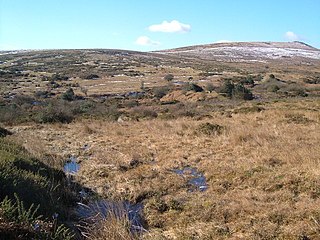
Bagtor is a historic estate in the parish of Ilsington in Devon, England. It was the birthplace of John Ford the playwright and poet. The Elizabethan mansion of the Ford family survives today at Bagtor as the service wing of a later house appended in about 1700.
















